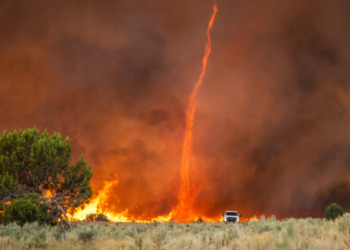Cybercrime poses an increasing threat to companies, organisations and individuals all over the world, with calls in the US to establish a treaty that clearly defines cybercrime to more easily prosecute offenders.
There is also growing concern about the link between climate change and cybersecurity. This is because the destabilisation in energy production and the individual desire to become greener creates opportunities for cybercrime to take place.
Scammers take advantage of the sense of urgency that the existential climate threat poses, convincing people to give them money or share personal information by posing as a trusted climate organisation. The Intergovernmental Panel on Climate Change (IPCC) even had to issue a statement warning people of scams being carried out by criminals using their name.
“IPCC has been made aware of various correspondences, being circulated via email, from Internet Web sites, and via regular mail or facsimile, falsely stating that they are issued by, or in association with, IPCC and/or its officials. These scams, which may seek to obtain money and/or in many cases personal details from the recipients of such correspondence, are fraudulent,” the IPCC wrote in the statement.
Cybercriminals will even exploit natural disasters by posing as charities collecting donations in the aftermath of a news-worthy crisis.
Don't be a victim of cybercrime. Protect yourself online by using strong passwords, keeping your software up-to-date, and being cautious online.
Follow @CISAgov and learn more
https://t.co/IFEZcwLDQv pic.twitter.com/YMSDXyhPyC
— Homeland Security (@DHSgov) April 26, 2023
Tricks like phishing, criminals posing as trusted groups or companies and asking you to provide personal information, malspam, spam emails containing a virus, and misinformation campaigns on social media can be avoided by the tech-savvy individual – but poor cybersecurity does pose a big threat to companies and organisations.
Cybersecurity and renewable business
The green energy industry is particularly vulnerable to cyber-attacks. This is because the new technologies that they rely on have not been hardened to combat cyber threats.
In 2021, the world’s biggest manufacturer of wind turbines was forced to shut down IT systems in several locations across the world following a cyber-attack. Danish company Vestas Wind Systems revealed after internal investigations that ransomware, a type of software that prevents the victim from using their programmes and accessing data unless a fee is paid, was behind the shutdown.
Related articles: TikTok Bans: Valid Cybersecurity Threats or ‘Political Theatre’?, The Race Against AI, How Green is Your Screen Time? The Carbon Footprint of Video Streaming, Kidnapping and Ransom, an Old and New Business.
Vestas reported a revenue of nearly €15 million in 2020, the eye-watering figure making it ideal prey for cybercriminals and a prominent target in the growing but vulnerable renewable energy sector.
Ransomware attacks grew by 485% in 2020 according to cyber security provider Bitdefender’s 2020 Consumer Threat Landscape Report – a worrying statistic that could mean that an extensive source of high-quality access to ransomware for cybercriminal groups has been created.
Speaking to InfoSecurity Magazine, Chloe Messdaghi, CEO and founder of Global Secure Partners, said that “as our world shifts towards clean energy, new systems will be developed and implemented, which will create new cybersecurity risks.”
Messdaghi also noted that the climate crisis creates cyber-risks on supply chains across the world, “particularly for industries that rely on raw materials, energy and transportation.” These companies, in an effort to reduce their carbon emissions, may turn to new suppliers and invest in new technologies, opening themselves up to cyber-attacks.
Other climate related threats
Extreme weather events have already demonstrated their impact on cybersecurity – Hurricane Sandy in 2012 caused huge security breaches on Wall Street, creating opportunities for hackers to break in.
Speaking to The National in 2012, Alan Brill, senior managing director of the cyber security and information assurance practice at the security company Kroll, said “flooding [caused by Hurricane Sandy and the subsequent storm] damaged computers and hard drives in hundreds if not thousands of businesses and organisations.”
The hurricane also provided independent scammers with an opportunity – one organisation’s helpdesk received a call urgently requesting an emergency download of all personnel information, claiming it would help assist staff affected by flooding. The organisation was unable to verify the integrity of the call due to the hurricane affecting internet conductivity in the area.
With climate change expected to continue making extreme weather events more frequent and severe , we should be prepared to see more cyber-attacks in the future.
Shifts in geopolitical landscapes, caused or fuelled by the effects of climate change, also have an impact on cybersecurity. Tensions between countries, driven by famine and increased movement of refugees, could also lead to cyber-attacks targeting critical government infrastructure and for espionage purposes.
According to Messdaghi, “we are not prepared” for the increased frequency of cyber-attacks that climate change will bring. The first step in ensuring higher levels of cyber security going forwards is to be more aware of the link between climate change and cybercrime. Organisations must build more resilient infrastructure when developing their green technology.
Editor’s Note: The opinions expressed here by the authors are their own, not those of Impakter.com — In the Featured Photo: Laptop keyboard. Featured Photo Credit: Unsplash.










